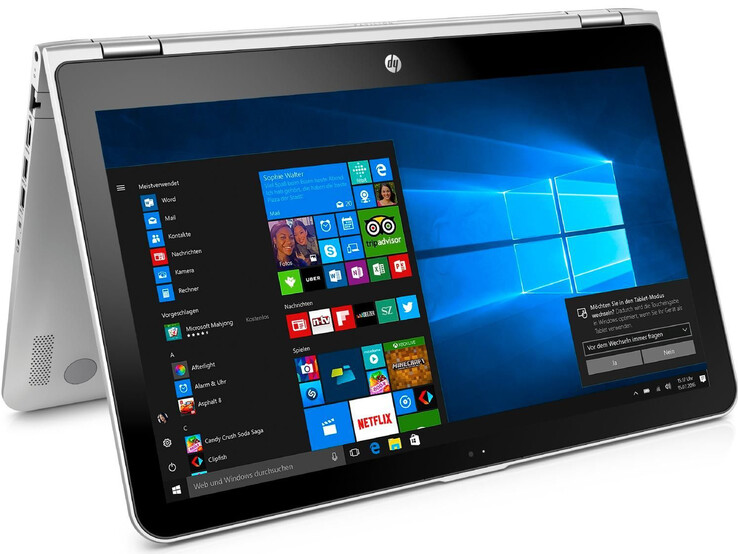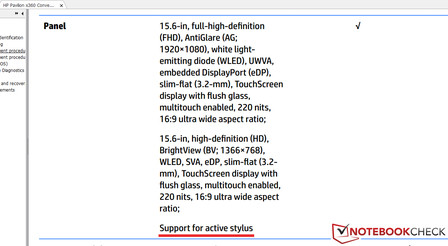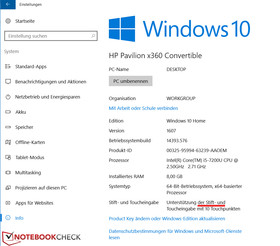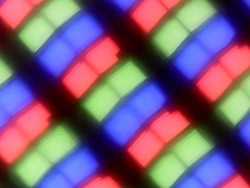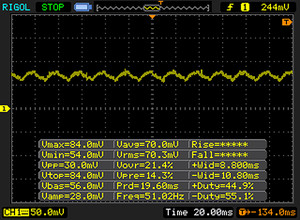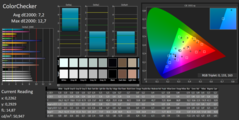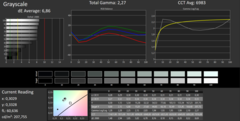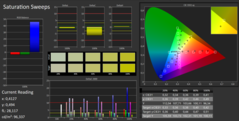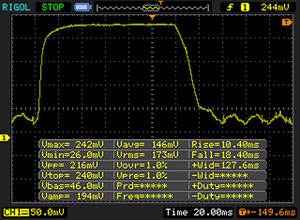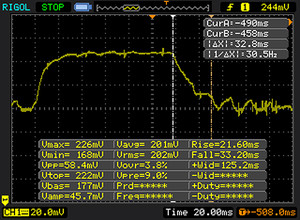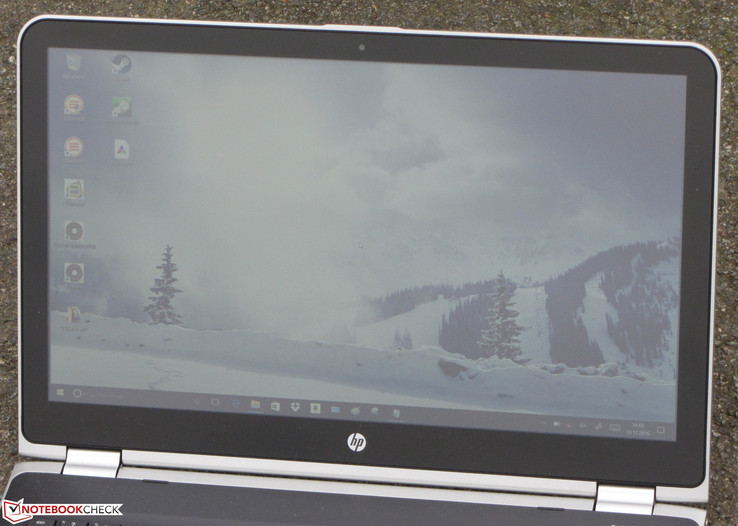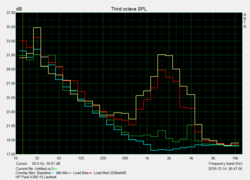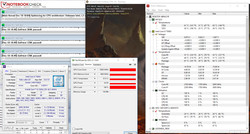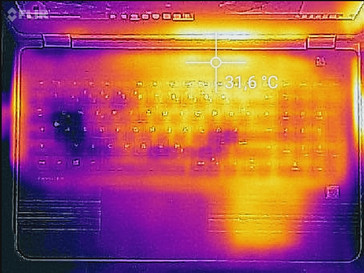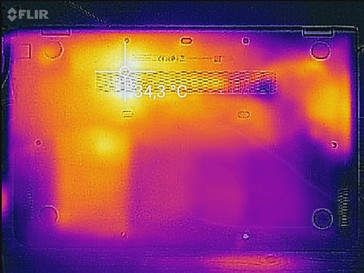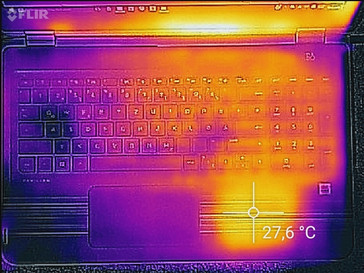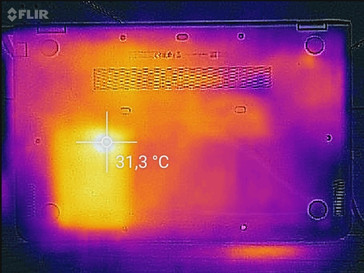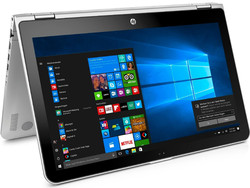HP Pavilion x360 15-bk102ng Convertible Review

We are familiar with the HP Pavilion x360 15-bk102ng. It is the sister model of the previously-reviewed HP Pavilion x360 15-bk001ng. There are certain differences on the inside: our current test model uses a Kaby Lake processor, whereas the sister model relies on a Skylake CPU. The competition of the Pavilion includes laptops, such as the Dell Inspiron 15 5568 and the Lenovo Yoga 510-15ISK.
The two Pavilion models have the same build. As such, we will not discuss the case, the connectivity, the input devices or the speakers in this review, unless there are significant differences. The information about these sections can be found in the review of the Pavilion x360 15-bk001ng.
| SD Card Reader | |
| average JPG Copy Test (av. of 3 runs) | |
| HP Pavilion 15-bk001ng x360 | |
| Lenovo Yoga 510-15ISK | |
| HP Pavilion x360 15-bk102ng | |
| Lenovo Yoga 510-14IKB | |
| Dell Inspiron 15 5568 | |
| maximum AS SSD Seq Read Test (1GB) | |
| HP Pavilion x360 15-bk102ng | |
| HP Pavilion 15-bk001ng x360 | |
| Lenovo Yoga 510-14IKB | |
| Lenovo Yoga 510-15ISK | |
| Dell Inspiron 15 5568 | |
| Networking | |
| iperf Server (receive) TCP 1 m | |
| Dell Inspiron 15 5568 | |
| Lenovo Yoga 510-14IKB | |
| iperf Client (transmit) TCP 1 m | |
| Dell Inspiron 15 5568 | |
| Lenovo Yoga 510-14IKB | |
| iperf3 transmit AX12 | |
| HP Pavilion x360 15-bk102ng | |
| iperf3 receive AX12 | |
| HP Pavilion x360 15-bk102ng | |
Input Devices
The keyboard of the Skylake sister model received a poor rating. It seems that we had a poorly-built test model, as our test model (with the same build) has a much better keyboard. The keys have short stroke distance and clear pressure points. Subjectively, they feel nice to the touch. While typing, the keyboard does not bend or deform. The placement of the keys is different from that of its sister model: some keys are not placed in their usual spots (for example, the hash key). Despite all of this, HP is offering a nice keyboard for home use.
The touchscreen of the Pavilion supports multi-finger input and styli (Active Pen). An appropriate pen has not been provided for this laptop and it seems that HP is not offering one for this model. If you want to use this feature, we recommend purchasing it separately. We tested the functionality with a stylus from "Hama". The touchscreen does not differentiate between different levels of pressure.
Display
The 15.6-inch screen of the Pavilion boasts with an FHD resolution of 1920x1080 pixels. The brightness of the screen is far too low at 190.7 cd/m². For this price, the brightness should be at least 250 cd/m². The contrast is fine, but unfortunately the panel suffers from PWM flickering (at 50 Hz). This can cause eye issues and headaches for users.
| |||||||||||||||||||||||||
Brightness Distribution: 74 %
Center on Battery: 205 cd/m²
Contrast: 683:1 (Black: 0.3 cd/m²)
ΔE Color 7.2 | 0.5-29.43 Ø5
ΔE Greyscale 6.86 | 0.57-98 Ø5.3
59% sRGB (Argyll 1.6.3 3D)
38% AdobeRGB 1998 (Argyll 1.6.3 3D)
40.76% AdobeRGB 1998 (Argyll 2.2.0 3D)
59.2% sRGB (Argyll 2.2.0 3D)
39.45% Display P3 (Argyll 2.2.0 3D)
Gamma: 2.27
| HP Pavilion x360 15-bk102ng IPS, 1920x1080, 15.60 | HP Pavilion 15-bk001ng x360 IPS, 1920x1080, 15.60 | Lenovo Yoga 510-14IKB IPS, 1920x1080, 14.00 | Dell Inspiron 15 5568 IPS, 1920x1080, 15.60 | Lenovo Yoga 510-15ISK IPS, 1920x1080, 15.60 | |
|---|---|---|---|---|---|
| Display | 6% | 6% | -4% | 8% | |
| Display P3 Coverage | 39.45 | 41.84 6% | 41.78 6% | 38.04 -4% | 42.58 8% |
| sRGB Coverage | 59.2 | 62.7 6% | 62.9 6% | 57.1 -4% | 63.9 8% |
| AdobeRGB 1998 Coverage | 40.76 | 43.25 6% | 43.17 6% | 39.3 -4% | 43.99 8% |
| Response Times | 120% | 185% | 20% | 2% | |
| Response Time Grey 50% / Grey 80% * | 55 ? | 30.8 ? 44% | 53 ? 4% | 42 ? 24% | 43.2 ? 21% |
| Response Time Black / White * | 26 ? | 22 ? 15% | 39 ? -50% | 22 ? 15% | 30.8 ? -18% |
| PWM Frequency | 50 ? | 200 ? 300% | 350 ? 600% | ||
| Screen | 26% | 16% | 23% | 25% | |
| Brightness middle | 205 | 225 10% | 243 19% | 266 30% | 254 24% |
| Brightness | 191 | 210 10% | 248 30% | 249 30% | 230 20% |
| Brightness Distribution | 74 | 85 15% | 91 23% | 85 15% | 86 16% |
| Black Level * | 0.3 | 0.22 27% | 0.32 -7% | 0.26 13% | 0.26 13% |
| Contrast | 683 | 1023 50% | 759 11% | 1023 50% | 977 43% |
| Colorchecker dE 2000 * | 7.2 | 4.13 43% | 5.44 24% | 4.98 31% | 4.23 41% |
| Colorchecker dE 2000 max. * | 12.7 | 9.36 26% | 9.73 23% | 11.82 7% | 9.5 25% |
| Greyscale dE 2000 * | 6.86 | 2.53 63% | 4.74 31% | 2.68 61% | 2.87 58% |
| Gamma | 2.27 97% | 2.6 85% | 2.38 92% | 2.27 97% | 2.35 94% |
| CCT | 6983 93% | 6360 102% | 7799 83% | 6583 99% | 5965 109% |
| Color Space (Percent of AdobeRGB 1998) | 38 | 39.8 5% | 39.6 4% | 36 -5% | 40.35 6% |
| Color Space (Percent of sRGB) | 59 | 62.5 6% | 62.5 6% | 57 -3% | 63.48 8% |
| Total Average (Program / Settings) | 51% /
40% | 69% /
46% | 13% /
17% | 12% /
19% |
* ... smaller is better
Screen Flickering / PWM (Pulse-Width Modulation)
| Screen flickering / PWM detected | 50 Hz | ≤ 20 % brightness setting | |
The display backlight flickers at 50 Hz (worst case, e.g., utilizing PWM) Flickering detected at a brightness setting of 20 % and below. There should be no flickering or PWM above this brightness setting. The frequency of 50 Hz is very low, so the flickering may cause eyestrain and headaches after extended use. In comparison: 53 % of all tested devices do not use PWM to dim the display. If PWM was detected, an average of 17900 (minimum: 5 - maximum: 3846000) Hz was measured. | |||
Display Response Times
| ↔ Response Time Black to White | ||
|---|---|---|
| 26 ms ... rise ↗ and fall ↘ combined | ↗ 10 ms rise | |
| ↘ 16 ms fall | ||
| The screen shows relatively slow response rates in our tests and may be too slow for gamers. In comparison, all tested devices range from 0.1 (minimum) to 240 (maximum) ms. » 57 % of all devices are better. This means that the measured response time is worse than the average of all tested devices (21.5 ms). | ||
| ↔ Response Time 50% Grey to 80% Grey | ||
| 55 ms ... rise ↗ and fall ↘ combined | ↗ 23 ms rise | |
| ↘ 32 ms fall | ||
| The screen shows slow response rates in our tests and will be unsatisfactory for gamers. In comparison, all tested devices range from 0.2 (minimum) to 636 (maximum) ms. » 90 % of all devices are better. This means that the measured response time is worse than the average of all tested devices (33.7 ms). | ||
HP has installed an IPS panel with strong viewing angles in our test model. The screen is legible from all angles. Outdoors, the Pavilion cannot be used comfortably due to the low brightness and the reflective nature of the panel. It is only possible to use the laptop outdoors on cloudy days.
Performance
The HP Pavilion is a 15.6-inch convertible with sufficient performance for usual tasks. Our test model is available for 600 Euros (~$632) and, at the time of testing, only one other model was available. This model had the same configuration as our test model, but it also has a red case. The Skylake sister models of the Pavilion are also available.
Processor
On the inside of the Pavilion, we have an Intel Core i5-7200U (Kaby Lake) dual-core processor. This is a middle-class ULV CPU (TDP: 15 W). The processor will suffice the needs of most users and offers performance reserves for the years to come. It operates at a base clock speed of 2.5 GHz and Turbo allows it to boost up to 3.1 GHz (both cores). The full performance is available while plugged in and while running on battery.
| Cinebench R10 | |
| Rendering Multiple CPUs 32Bit | |
| HP Pavilion x360 15-bk102ng | |
| Lenovo Yoga 510-15ISK | |
| HP Pavilion 15-bk001ng x360 | |
| Rendering Single 32Bit | |
| HP Pavilion x360 15-bk102ng | |
| Lenovo Yoga 510-15ISK | |
| HP Pavilion 15-bk001ng x360 | |
| Geekbench 3 | |
| 32 Bit Single-Core Score | |
| HP Pavilion x360 15-bk102ng | |
| Lenovo Yoga 510-15ISK | |
| 32 Bit Multi-Core Score | |
| HP Pavilion x360 15-bk102ng | |
| Lenovo Yoga 510-15ISK | |
| Geekbench 4.0 | |
| 64 Bit Single-Core Score | |
| HP Pavilion x360 15-bk102ng | |
| 64 Bit Multi-Core Score | |
| HP Pavilion x360 15-bk102ng | |
| JetStream 1.1 - Total Score | |
| HP Pavilion x360 15-bk102ng | |
| Dell Inspiron 15 5568 | |
| Lenovo Yoga 510-15ISK | |
System Performance
The system runs smoothly and we did not encounter any issues. The PC Mark benchmark results are good and indicate that the system performs at a high level. This means that the laptop will tackle office tasks and web surfing very well. It is possible to increase the performance by swapping the HDD out for an SSD. This would allow the system to load faster. Furthermore, the user can install a second RAM module. This would boost the graphics performance. This procedure is difficult as the case must be opened first. In addition, the user must remove the mainboard.
| PCMark 8 Home Score Accelerated v2 | 3173 points | |
Help | ||
| PCMark 8 - Home Score Accelerated v2 | |
| Lenovo Yoga 510-15ISK | |
| Dell Inspiron 15 5568 | |
| Lenovo Yoga 510-14IKB | |
| HP Pavilion x360 15-bk102ng | |
| HP Pavilion 15-bk001ng x360 | |
Storage Device
The system drive is a standard 2.5-inch disk from Western Digital. It runs at 5400 RPM and has a capacity of 1 TB. Its transfer speeds are normal for a 5400 RPM drive.
| HP Pavilion x360 15-bk102ng WDC Slim WD10SPCX-21KHST0 | HP Pavilion 15-bk001ng x360 WDC Slim WD10SPCX-21KHST0 | Lenovo Yoga 510-14IKB Samsung MZYTY256HDHP | Dell Inspiron 15 5568 Toshiba THNSNK256GCS8 | Lenovo Yoga 510-15ISK Liteonit CV3-DE256 | |
|---|---|---|---|---|---|
| CrystalDiskMark 3.0 | 6% | 11043% | 8268% | 8778% | |
| Read Seq | 102.4 | 106.9 4% | 518 406% | 458.6 348% | 487 376% |
| Write Seq | 102 | 106 4% | 476.5 367% | 270 165% | 450.7 342% |
| Read 512 | 31.37 | 33.01 5% | 408 1201% | 397.4 1167% | 384.5 1126% |
| Write 512 | 48.12 | 51.2 6% | 274.5 470% | 242 403% | 356.3 640% |
| Read 4k | 0.357 | 0.373 4% | 35.66 9889% | 19.88 5469% | 27.05 7477% |
| Write 4k | 1.047 | 1.097 5% | 106.7 10091% | 86.7 8181% | 63.7 5984% |
| Read 4k QD32 | 0.844 | 1.029 22% | 368.7 43585% | 275.3 32518% | 281.5 33253% |
| Write 4k QD32 | 1.098 | 1.055 -4% | 246.3 22332% | 197.6 17896% | 232 21029% |
Graphics Card
The graphics output is an Intel HD Graphics 620 GPU. It supports DirectX 12 and runs at up to 1000 MHz. The 3D Mark benchmark results confirm the expected performance for this chip. If a second RAM is installed (= dual-channel mode active), the graphics performance can be further boosted. This Intel graphics chip can compete with entry-level dedicated GPUs.
| 3DMark 11 Performance | 1445 points | |
Help | ||
| 3DMark 11 - 1280x720 Performance GPU | |
| Lenovo Yoga 510-15ISK | |
| Lenovo Yoga 510-14IKB | |
| Dell Inspiron 15 5568 | |
| HP Pavilion x360 15-bk102ng | |
| HP Pavilion 15-bk001ng x360 | |
Gaming Performance
The Pavilion can run many games smoothly, but only at low resolution and details. This only applies to games which are not very demanding. Hardware-hungry games, such as, “Mafia 3”, never ran well on our test model. The installation of a second RAM module did not improve the situation much. Thanks to dual-channel mode, the graphics chip could push out a few more frames, but for a game like “Mafia 3”, this was far too little.
| low | med. | high | ultra | |
| BioShock Infinite (2013) | 39 | 22.6 | 18.2 | 5.8 |
Emissions
Noise Emissions
This HP laptop has a "Fan always on" option in the BIOS. This would allow the fan to run continuously while the laptop is on. If the user turns this option off, the fan will turn off when the laptop is idle. At low speeds, the fan is barely audible. At load, the story changes: the maximum noise emission measures 38.8 dB(A). This would not be bad by itself, but sadly, in combination with the whirring noise emitted by the fan, the noise emissions can be distracting.
Noise Level
| Idle |
| 31.7 / 31.7 / 31.7 dB(A) |
| Load |
| 38.8 / 36.8 dB(A) |
 | ||
30 dB silent 40 dB(A) audible 50 dB(A) loud |
||
min: | ||
Temperatures
The Pavilion can run our stress test the same way whether it is plugged in or on battery. In the first 5 minutes, the CPU runs at 2.7 GHz. The GPU runs at 850 to 900 MHz. Afterwards, the CPU speeds drop to 2.3 to 2.4 GHz. At the same time, the GPU accelerates to 950 to 1000 MHz. The Pavilion does not really heat up, since during the stress test, the laptop exceeded the 30 degrees Celsius (~86 degrees Fahrenheit) mark only at one spot.
(+) The maximum temperature on the upper side is 29 °C / 84 F, compared to the average of 35.3 °C / 96 F, ranging from 19.6 to 55.7 °C for the class Convertible.
(+) The bottom heats up to a maximum of 32 °C / 90 F, compared to the average of 36.8 °C / 98 F
(+) In idle usage, the average temperature for the upper side is 22.3 °C / 72 F, compared to the device average of 30.2 °C / 86 F.
(+) The palmrests and touchpad are cooler than skin temperature with a maximum of 28 °C / 82.4 F and are therefore cool to the touch.
(±) The average temperature of the palmrest area of similar devices was 28.1 °C / 82.6 F (+0.1 °C / 0.2 F).
HP Pavilion x360 15-bk102ng audio analysis
(-) | not very loud speakers (65 dB)
Bass 100 - 315 Hz
(-) | nearly no bass - on average 19.9% lower than median
(±) | linearity of bass is average (12.4% delta to prev. frequency)
Mids 400 - 2000 Hz
(+) | balanced mids - only 4.2% away from median
(±) | linearity of mids is average (7% delta to prev. frequency)
Highs 2 - 16 kHz
(+) | balanced highs - only 2.3% away from median
(+) | highs are linear (6.2% delta to prev. frequency)
Overall 100 - 16.000 Hz
(±) | linearity of overall sound is average (21.2% difference to median)
Compared to same class
» 52% of all tested devices in this class were better, 12% similar, 36% worse
» The best had a delta of 6%, average was 21%, worst was 57%
Compared to all devices tested
» 54% of all tested devices were better, 7% similar, 39% worse
» The best had a delta of 4%, average was 25%, worst was 134%
Apple MacBook 12 (Early 2016) 1.1 GHz audio analysis
(+) | speakers can play relatively loud (83.6 dB)
Bass 100 - 315 Hz
(±) | reduced bass - on average 11.3% lower than median
(±) | linearity of bass is average (14.2% delta to prev. frequency)
Mids 400 - 2000 Hz
(+) | balanced mids - only 2.4% away from median
(+) | mids are linear (5.5% delta to prev. frequency)
Highs 2 - 16 kHz
(+) | balanced highs - only 2% away from median
(+) | highs are linear (4.5% delta to prev. frequency)
Overall 100 - 16.000 Hz
(+) | overall sound is linear (10.2% difference to median)
Compared to same class
» 5% of all tested devices in this class were better, 2% similar, 93% worse
» The best had a delta of 5%, average was 19%, worst was 53%
Compared to all devices tested
» 3% of all tested devices were better, 1% similar, 96% worse
» The best had a delta of 4%, average was 25%, worst was 134%
Frequency diagram for comparison (checkboxes can be selected!)
Energy Use
Power Consumption
While idle, the maximum power consumption is 9.3 W. This is typical for devices such as the Pavilion. During the stress test, the consumption rises to 32.9 W. This value would be higher if the processor operated at full power. At medium load (3D Mark 2006 running), the laptop is already capped out. As such, the consumption would be much higher, if the CPU were not throttled. The power adapter has a specification of 45 W.
| Off / Standby | |
| Idle | |
| Load |
|
Battery Life
Our practical WLAN test simulates the load the laptop experiences when surfing the web. The power profile is set to "Balanced" and the power saver functions are turned off. The brightness is set to roughly 150 cd/m². The Pavilion reaches a run time of 5:48 hours, which places it one hour behind its Skylake sister model (6:41 hours).
| Battery Runtime - WiFi Websurfing | |
| HP Pavilion 15-bk001ng x360 | |
| Lenovo Yoga 510-14IKB | |
| HP Pavilion x360 15-bk102ng | |
| Lenovo Yoga 510-15ISK | |
| Dell Inspiron 15 5568 | |
Pros
Cons
Verdict
HP is offering a 15.6-inch convertible with sufficient performance for most tasks. The laptop runs quietly while idle and barely heats up. A 1 TB HDD offers extensive storage space and the user can swap it out for an SSD (after opening the case). A maintenance flap is not included. The keyboard is fine for home use. The battery life of the Pavilion in our WLAN test is average, which means that the convertible is not ideal for mobile use.
The screen is good, but not great. The low brightness is the Achilles' heel of our test model.
For 600 Euros (~$632), HP has to put more on the table. The IPS panel has good viewing angles and decent contrast. The keyboard, touchpad and touchscreen work well. The screen reacts quickly and accurately to input and can be used with a finger or an active stylus. Despite the many pros, the cons of this model will dissuade many potential buyers.
HP Pavilion x360 15-bk102ng
-
12/22/2016 v6(old)
Sascha Mölck


 Deutsch
Deutsch English
English Español
Español Français
Français Italiano
Italiano Nederlands
Nederlands Polski
Polski Português
Português Русский
Русский Türkçe
Türkçe Svenska
Svenska Chinese
Chinese Magyar
Magyar